Easy treatment with expert
24/7 Emergency Available
Advice with Experts
We understand that injuries and acute pain can happen unexpectedly. Our emergency physiotherapy services are designed to provide prompt and effective care to help you manage pain, prevent further injury, and start your recovery process as quickly as possible.
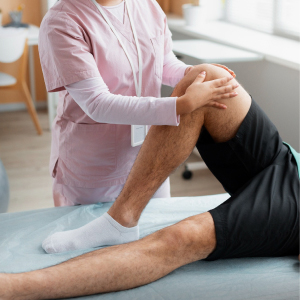
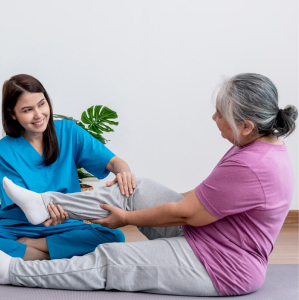



We offer top-quality physiotherapy services tailored to your needs. Our expert therapists use advanced techniques to treat pain, improve mobility.

Physiotherapy treatment in Brampton supports individuals across a wide spectrum of physical health concerns, with an approach grounded in clinical assessment, movement science, and rehabilitation practices. It’s a collaborative and functional intervention that assists people in restoring movement, managing pain, and improving their capacity for daily life activities. Whether you’re facing limitations after surgery, managing a long-standing musculoskeletal issue, or working toward improved physical performance, physiotherapy offers tools and strategies to support recovery and adaptation.
Brampton, a growing and active city, sees a wide variety of needs when it comes to physical rehabilitation and functional health. Workplace injuries, sports participation, chronic conditions, and aging-related changes often bring about mobility concerns. Physiotherapy, with its structured and outcome-focused methods, helps individuals manage and overcome these issues. From teens recovering from athletic injuries to seniors working to maintain independence, physiotherapy treatment plays a vital role in physical health support throughout Brampton.
Physiotherapy treatment begins with an in-depth evaluation. This typically includes a review of medical history, functional assessments, posture and movement analysis, and discussion of symptoms or challenges. Treatment strategies are then aligned with the individual’s specific needs, often incorporating:
Physiotherapy in Brampton is not limited to one type of health issue. It has proven application across a wide range of conditions, including—but not limited to—the following:
This includes sprains, strains, joint pain, tendonitis, and overuse injuries. Post-fracture rehabilitation and post-operative joint repair recovery are also common areas addressed through structured physiotherapy protocols.
Neurological impairments such as stroke, Parkinson’s disease, multiple sclerosis, and spinal cord injuries can benefit significantly from consistent physiotherapy interventions. Movement re-education, neuromuscular facilitation, and balance retraining help improve independence and mobility in daily tasks.
Patients recovering from cardiac surgeries or managing respiratory illnesses like COPD and asthma benefit from tailored physiotherapy programs that focus on aerobic endurance, airway clearance, and improved breathing mechanics.
Pain conditions that persist beyond the normal healing timeframe such as arthritis, fibromyalgia, or complex regional pain syndrome (CRPS) can be effectively managed through a combination of education, mobility work, and physical conditioning.
Whether after joint replacement, spinal surgery, or ligament reconstruction, physiotherapy helps support tissue healing and restore movement while minimizing complications or compensatory patterns.
Physiotherapy treatment in Brampton includes dedicated protocols for sports-related injuries. From weekend runners to competitive athletes, sports injuries are often complex and demand targeted recovery pathways. Common injuries treated include:
Rehabilitation plans are structured to progress from pain relief to strength-building and sports-specific training, aiming for a safe return to full activity.
One of the key pillars of physiotherapy in Brampton is prevention. The goal isn’t only to treat existing problems but to reduce the chance of future limitations. This includes:
This proactive aspect of physiotherapy supports individuals in maintaining independence and reducing healthcare risks over time.
A dedicated branch of physiotherapy focuses on issues experienced during pregnancy, postnatal recovery, or related to pelvic health. These may include:
Individualized therapy plans may include pelvic floor strengthening, lifestyle guidance, and body mechanics education.
Physiotherapy brings with it a wide array of benefits, all anchored in measurable functional change and day-to-day improvements. These outcomes often include:
Targeted interventions such as manual techniques, stretches, and movement training help manage pain across a variety of conditions.
Improving mobility, flexibility, and strength allows people to move more freely and safely in their home, work, and social environments.
Therapy is geared toward enabling individuals to better manage their responsibilities—whether it’s commuting, playing with children, or returning to sports.
Post-injury or post-operative programs accelerate the healing process and minimize the duration of downtime or bedrest.
By improving body mechanics and stability, physiotherapy supports long-term musculoskeletal health and reduces the chances of re-injury.
As movement improves, so does the ability to engage more fully in life’s demands, from personal care to leisure activities.
Physiotherapy is suitable for individuals across all age groups and fitness levels. Those who may benefit include:

Massage therapy plays a vital role in supporting physical and mental wellness. By focusing on the manipulation of soft tissues such as muscles, tendons, and ligaments it aims to relieve discomfort, manage tension, and help the body function more efficiently. In Brampton, massage therapy is widely used as part of a larger strategy for those dealing with muscular stress, injuries, or general fatigue.
Massage therapy involves applying pressure, motion, and targeted techniques to soft tissues. It is commonly used to address muscle tightness, circulation concerns, and physical stress. Whether used for managing a specific condition or simply to unwind, it fits into many wellness routines across different lifestyles.
Massage therapy can be delivered in several styles and techniques, depending on the individual’s needs. Some of the widely available options in Brampton include:
This technique uses smooth, flowing strokes to improve circulation and promote relaxation. It is generally lighter in pressure and ideal for those seeking a soothing experience to reduce daily stress or mild muscle discomfort.
Designed to address deeper muscle layers and connective tissue, this approach applies firmer pressure. It’s typically used for chronic muscle tension, postural issues, or after prolonged physical strain.
Intended for athletes and those who regularly engage in physical activity, sports massage focuses on muscle recovery, flexibility, and injury prevention. It can also be used pre- or post-event to optimize movement and reduce soreness.
This technique targets specific muscle knots or areas of tightness that may be causing referred pain. By applying sustained pressure to these points, the surrounding muscle tissue can release and relax.
This method works on fascia—the connective tissue around muscles and bones. By addressing restrictions in this tissue, myofascial release can help improve mobility and ease stiffness or discomfort.
During a session, the individual typically lies on a padded massage table in a quiet, private room. The therapist may ask some questions about symptoms, lifestyle, and goals before beginning. Based on this initial discussion, the therapist selects suitable techniques and adjusts pressure levels accordingly.
Massage oil or lotion is often used to allow smooth hand movements. The therapist may focus on one area or provide full-body coverage depending on the concern. Open communication is encouraged throughout the session to ensure comfort and proper technique.
The recommended frequency of sessions can differ based on individual goals. Those dealing with ongoing pain or recovery from physical exertion may choose weekly sessions. Others looking to maintain general wellness or manage occasional stress might find benefit from monthly or bi-monthly visits.
There’s no fixed rule—some people respond better to more regular treatment, while others prefer less frequent appointments. It’s important to track how your body reacts and adjust accordingly.
Massage therapy is not meant to cause pain. However, some techniques such as deep tissue or trigger point work may produce brief discomfort, especially in tense or inflamed areas. This sensation should not be overwhelming, and therapists can reduce pressure if necessary. Clear communication helps maintain a safe and effective experience.
Massage therapy is used in Brampton for a wide range of physical and mental conditions. Common reasons for seeking this care include:
Massage therapy can be integrated with other health approaches or used independently for maintenance.
Each person’s response to massage therapy will differ. Some may feel relaxed and relieved immediately after the first session, while others may notice gradual progress over time—especially if the concern is chronic. Muscle patterns that have developed over years may take multiple visits to respond fully.
It’s also important to support massage with hydration, stretching, and body awareness between sessions. Regular attention to the body’s signals helps extend the positive effects of treatment.
Massage therapy in Brampton can be suitable for many individuals, such as:
Anyone considering massage therapy should inform the therapist of any medical conditions, recent surgeries, or current treatments to ensure the session is appropriate.
Many people feel calm or physically lighter after their massage. Others may feel slightly sore—similar to post-exercise fatigue—especially if deep tissue or focused techniques were used. Staying hydrated, avoiding strenuous activity for a few hours, and getting adequate rest can help enhance the outcome.
Mild soreness generally fades within 24-48 hours, giving way to a more flexible, relaxed state. Repeat sessions may continue to build on this progress.
When selecting a provider, consider the following factors:
A brief phone consultation or first session can often help determine whether the fit is right for ongoing care.
....
Chiropractic adjustment in Brampton emphasizes the relationship between the spine and the nervous system. This approach aims to improve function, reduce physical discomfort, and support the body’s natural ability to maintain health without reliance on medication or surgical intervention. This service page provides a detailed understanding of chiropractic care, how it works, and what individuals can expect from treatment in Brampton.
Chiropractic care is a manual therapy that targets the musculoskeletal system, especially the spine. It is based on the principle that misalignments in the spine can disrupt the nervous system and affect overall function. Practitioners use controlled force and precise movements to adjust these misalignments, also referred to as subluxations.
By restoring alignment, chiropractic care supports the nervous system’s communication with the rest of the body, aiming to create a more balanced and functional system. This hands-on approach does not involve medication or surgical procedures, offering an option for those who prefer natural methods for addressing musculoskeletal issues.
During a chiropractic session, a practitioner typically performs spinal adjustments using their hands or specialized instruments. These adjustments involve applying a targeted and controlled force to specific joints. The goal is to correct spinal alignment, relieve pressure on surrounding nerves, and encourage better movement.
Techniques may vary depending on the patient’s condition, age, and comfort level. Some sessions may include soft tissue therapy, mobility exercises, or postural guidance to support ongoing results. Each treatment is generally personalized to meet the needs of the individual and address the root of the discomfort rather than just the symptoms.
Most individuals find chiropractic adjustments to be tolerable, and many report a sense of release or relief immediately afterward. Some may hear a “popping” or “cracking” sound during the adjustment, which is simply the release of gas from the joints and is considered normal.
Temporary soreness or stiffness may occur, especially after the first few visits, as the body adjusts to new alignment patterns. This usually resolves within a day or two and is part of the body’s natural response to manual intervention.
Responses to chiropractic care vary from person to person. Some individuals experience improvement after their first session, while others may require a series of visits before noticing significant changes.
Factors influencing the timeline include:
Progress is typically monitored throughout treatment. Based on observed changes, the chiropractor may adjust the care plan accordingly.
Some individuals choose to continue with chiropractic visits even after their primary concern has been addressed. Ongoing sessions can support mobility, posture, and musculoskeletal balance over time.
Maintenance care is especially common among those with physically demanding routines, chronic conditions, or postural concerns. These sessions are typically less frequent and serve as a method of preventive support. The decision to continue treatment should be discussed with the chiropractor and based on individual goals and lifestyle.
Chiropractic adjustment in Brampton can be used to manage a variety of concerns related to the spine, joints, and muscles. Some commonly addressed issues include:
The effectiveness of care can vary depending on the nature of the condition and how early treatment begins.
The first session typically includes a comprehensive assessment. This may involve a review of medical history, lifestyle habits, a physical examination, and possibly diagnostic imaging. This step helps form an accurate understanding of the root cause and determine whether chiropractic care is suitable.
A chiropractic session usually lasts between 30 to 60 minutes. Initial assessments are typically longer due to the thorough examination process. Follow-up visits tend to be shorter and more focused on adjustments and progress tracking.
During an adjustment, the chiropractor may use:
Patients may also receive movement education or ergonomic guidance to support outcomes between sessions.
When performed by a trained and licensed practitioner, chiropractic care is generally considered safe for many individuals. However, like all health-related interventions, it carries some risks. These may include temporary discomfort, fatigue, or minor soreness. It’s essential to disclose all health conditions, previous injuries, and current symptoms during the assessment to ensure that treatment is appropriate.
Chiropractic care is often used in conjunction with other non-invasive therapies. For individuals with more complex conditions, collaboration with other healthcare providers may be recommended.
Chiropractic adjustment in Brampton is part of a broader strategy that supports mobility and helps reduce the impact of physical stress on the body. It may be used for both recovery and ongoing care, particularly for individuals with repetitive strain from work, athletic activities, or age-related changes.
Some people seek care after injuries or during periods of increased physical demand, while others adopt it as part of a broader lifestyle approach. In either case, the aim is to enhance movement and function through non-invasive methods.
Whether you are seeking options for managing discomfort or aiming to support long-term musculoskeletal balance, chiropractic adjustment can be an effective route. With its focus on spine and joint function, this approach provides a hands-on method to address physical strain without pharmacological intervention.
If you’re considering chiropractic adjustment in Brampton, a thorough consultation with a qualified provider is the recommended starting point. Through evaluation and discussion of your needs, a personalized plan can be developed to align with your physical health goals.
....
Motor Vehicle Accident (MVA) treatment refers to a structured rehabilitation process intended to help individuals recover from physical injuries sustained in car accidents. These injuries can range from whiplash and muscle sprains to more complex conditions involving joints, ligaments, and nerves.
The treatment process typically includes assessment, therapeutic intervention, and gradual reconditioning. The overall focus is to manage symptoms, improve physical function, and assist in the individual’s return to daily life.
After an accident, many people experience delayed pain and restricted movement that may worsen over time. Even low-speed impacts can result in physical dysfunction, and without timely care, these issues may lead to longer-term impairment.
Addressing these problems early allows for better management and supports the body’s natural healing process.
A range of evidence-based approaches is used to support individuals recovering from car accident injuries. Each treatment plan is adjusted according to injury type, severity, medical history, and personal goals.
Hands-on methods are often used to reduce tension, improve blood flow, and support better movement. Techniques may include joint mobilization, myofascial release, or passive stretching.
Prescribed movements help restore range of motion, rebuild strength, and stabilize the affected regions. Programs are designed progressively to match the individual’s recovery stage.
Technologies such as ultrasound, TENS (Transcutaneous Electrical Nerve Stimulation), and heat or cold therapy may be used to reduce inflammation, ease discomfort, or assist muscle recovery.
Understanding proper posture, lifting techniques, and pacing strategies supports recovery outside of clinic visits. Clients are guided in building routines that reduce re-injury risk.
Treatment plans evolve over time, responding to ongoing assessment. This stepwise increase in treatment complexity ensures appropriate challenges are introduced at each phase.
Motor vehicle collisions can cause a broad range of injuries. Some of the frequently addressed conditions in post-accident treatment programs include:
These conditions can have varying recovery timelines. Early identification and targeted intervention are essential for managing symptoms and preventing chronic limitations.
The process to start treatment following a car accident is designed to be clear and accessible:
The first step is to schedule an assessment. This allows the care provider to gather information about the accident, symptoms, medical history, and insurance status.
A full clinical assessment is conducted. This includes physical testing, functional evaluation, and discussion of symptoms. The findings are used to develop an appropriate treatment approach.
Once assessed, the individual begins treatment. A combination of manual therapy, exercise, modalities, and educational components is introduced based on the person’s condition.
Treatment is adjusted as the person recovers. Regular progress evaluations ensure that therapy remains aligned with recovery milestones.
Once goals are met, discharge planning includes home strategies and exercise maintenance. Follow-up or occasional check-ins may be recommended depending on the case.
In Ontario, individuals injured in motor vehicle accidents may be eligible for physiotherapy and rehabilitation services through their auto insurance policy under the Statutory Accident Benefits Schedule (SABS).
To access these benefits:
Documentation and communication with adjusters are often part of the process, and many clinics assist patients in navigating these procedures.
The duration of treatment depends on several factors:
Some individuals require only a few weeks of care, while others may benefit from several months of progressive rehabilitation.
While some individuals experience immediate pain, others may not notice symptoms for days or even weeks. It’s recommended to seek assessment if you experience:
Early intervention often contributes to better long-term outcomes.
....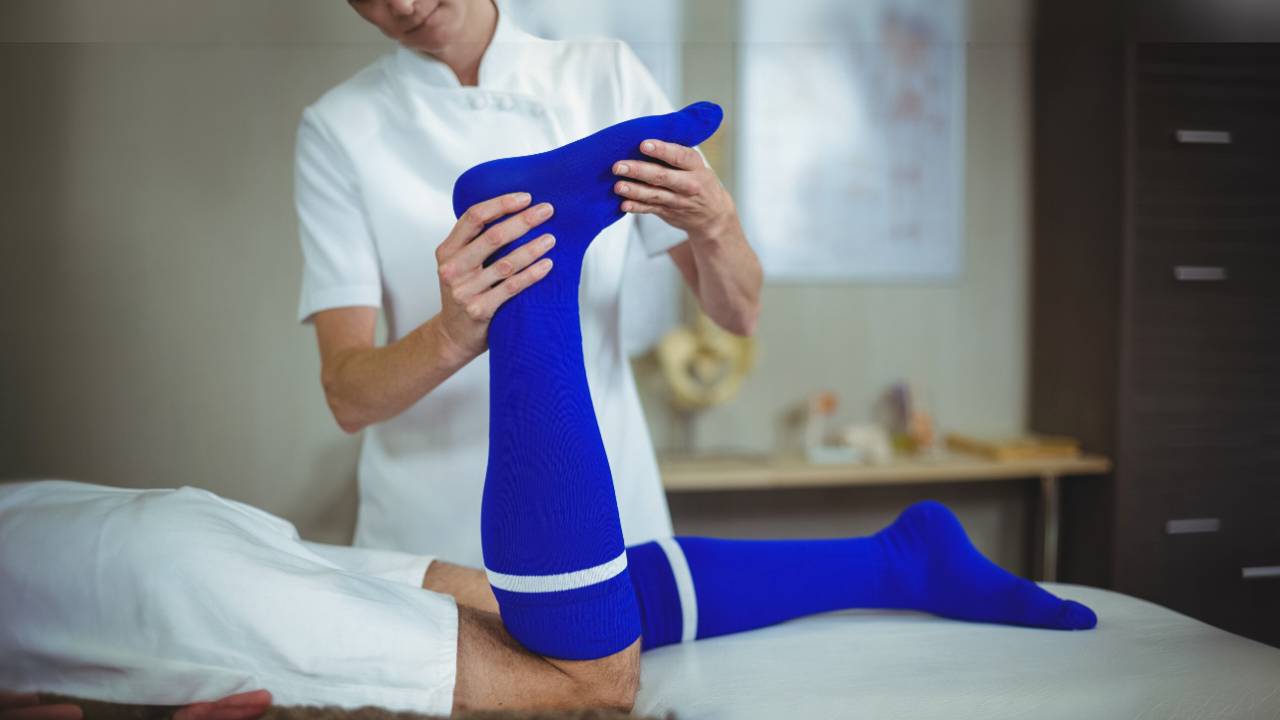
Compression stockings are commonly used to support leg circulation and ease lower limb discomfort. In Brampton, they are frequently recommended to individuals with circulation concerns, swelling, or extended periods of standing or sitting. These garments apply consistent pressure to the legs, which encourages healthy blood flow and minimizes pooling in the veins. For many, compression stockings serve as an important part of everyday support for leg health.
Compression stockings are snug-fitting garments that exert gentle pressure on the legs. The design typically features graduated compression — with the strongest pressure at the ankle that reduces gradually toward the thigh. This pressure helps veins and muscles move blood more effectively back toward the heart.
These stockings are available in various lengths (knee-high, thigh-high, and full pantyhose styles) and different levels of compression, often measured in millimeters of mercury (mmHg). Selecting the correct type often depends on an individual’s health goals and should be guided by clinical assessment when necessary.
Compression stockings in Brampton utilize graduated compression, this means they apply the most pressure at the ankle and gradually reduce that pressure as the stocking moves up the leg. This structure helps counteract the effects of gravity, which can otherwise lead to blood pooling in the lower extremities.
When blood is unable to flow efficiently back to the heart, individuals may experience symptoms such as swelling (edema), varicose veins, leg fatigue, or even blood clots in severe cases. The mechanical support provided by these stockings addresses these concerns directly by assisting venous return and helping to distribute pressure more evenly throughout the lower body.
In many cases, individuals in Brampton turn to compression stockings after receiving medical guidance due to circulatory issues or other leg-related concerns. Some groups that may benefit include:
One of the primary advantages of using compression stockings in Brampton is improved circulation. The graduated compression design supports venous return, which may reduce the risk of blood pooling and clot formation. Individuals with chronic venous insufficiency often rely on this kind of support to manage their symptoms and slow the progression of their condition.
Compression stockings can help control swelling that occurs in the feet, ankles, and calves. This is particularly helpful after long days of walking, standing, or traveling. In a city like Brampton, where individuals engage in diverse work environments, this benefit has daily significance for many.
Those who experience aching or tired legs at the end of the day may find relief by wearing compression stockings. The garments provide support that reduces muscle vibration, minimizes lactic acid build-up, and lessens overall fatigue. People who work extended shifts or maintain an active routine can feel the difference in leg function and endurance.
Following surgery, medical professionals in Brampton may suggest compression stockings to reduce complications like DVT or to support wound healing by encouraging circulation. In cases involving orthopedic or vascular recovery, these garments often become part of a structured rehabilitation plan.
Athletes in Brampton also use compression stockings to assist with performance and recovery. The garments may help reduce delayed-onset muscle soreness (DOMS) and support better post-exercise recovery by stimulating blood flow and reducing muscle inflammation.
Compression stockings in Brampton come in a variety of lengths, pressure ratings, and designs, each tailored to different needs. Options include:
It’s important to select the correct compression level (measured in mmHg) based on the reason for use. A medical consultation can guide the decision regarding low (8–15 mmHg), moderate (15–20 mmHg), or high (20–30 mmHg and above) pressure ratings.
Compression stockings are generally worn during the day, especially during periods of activity or travel. Putting them on first thing in the morning, before swelling begins, is typically advised. Depending on the type, they can be worn for several hours at a time or throughout the day.
For those living in Brampton’s varied climate, breathable and moisture-wicking fabric options help ensure comfort, even during warmer months. Washing and replacing stockings regularly is also important, as elasticity plays a key role in their effectiveness.
Before purchasing or wearing compression stockings in Brampton, a few considerations should be kept in mind:
If symptoms worsen or new issues arise while using compression stockings, seeking advice from a healthcare provider is important.
....
Foot discomfort, improper gait, and posture-related challenges can often be traced back to structural imbalances in the feet. Whether you’re managing daily fatigue, sports-related discomfort, or alignment issues, Custom Made Orthotics in Brampton may offer the structural support you’ve been looking for. These orthotic devices are crafted for individual foot structures, helping enhance alignment, function, and daily comfort.
Custom made orthotics are individually designed inserts placed inside footwear to improve foot function. Unlike mass-produced insoles found in stores, these are tailored to match the unique contours and movement patterns of your feet. Crafted using biomechanical assessments and pressure mapping technology, these orthotics are created to help manage various structural and functional issues affecting the lower body.
These foot supports are designed using materials that range from soft foams to rigid plastics, depending on the condition being addressed and the person’s activity level. Each orthotic is custom-built to cater to the individual’s foot shape, stride, and concerns, allowing for targeted support.
Several types of Custom Made Orthotics in Brampton are available based on the level of support and function required:
These are made from firm materials and are often used to control motion in the joints of the foot and ankle. They are particularly useful for conditions like flat arches or joint instability.
Constructed from cushioning materials, soft orthotics are used to reduce pressure on sensitive areas. They are typically recommended for people with diabetic foot conditions or plantar fasciitis.
Blending soft and firm elements, semi-rigid orthotics offer stability while maintaining flexibility. These are frequently used by athletes and individuals with active lifestyles to address movement-related discomfort or overuse issues.
Custom Made Orthotics in Brampton are more than just insoles; they are functional devices that help manage and prevent biomechanical problems. The following are common reasons individuals may seek custom orthotic support:
Orthotics help redistribute pressure, support natural movement, and correct alignment patterns that may contribute to ongoing discomfort or strain.
Custom Made Orthotics in Brampton operate by adjusting the positioning of the foot to achieve more balanced alignment and gait. They work by:
Over time, these corrections can improve posture, reduce discomfort in the knees and back, and allow for improved physical performance during daily activities.
Orthotics are often used as part of a broader management plan to address issues including:
By focusing on foot mechanics, orthotics can play a vital role in improving mobility and reducing stress on related joints and muscles.
For individuals seeking Custom Made Orthotics in Brampton, the process begins with a detailed consultation. This assessment includes several steps to ensure accuracy and function:
An in-depth review of your foot shape, arch type, and pressure points is conducted. This step identifies any asymmetries or imbalances in structure or function.
Observing how you walk is essential. Gait analysis tools, such as pressure mats or motion sensors, may be used to detect abnormalities in stride, foot contact, and balance.
A discussion of physical activities, work habits, footwear use, and medical history helps determine the specific demands placed on your feet.
If required, a 3D scan or foam mold of the feet is created to provide an exact model for building the orthotic. These tools ensure precise alignment to your unique foot shape.
Once fabricated, your orthotics are tested in your footwear to ensure proper fit and comfort. Adjustments may be made to achieve optimal support.
The functionality of Custom Made Orthotics in Brampton extends to various lifestyle needs:
Orthotics are designed to be worn daily and fit into a variety of shoes, including athletic shoes, boots, and some dress shoes. Over time, these inserts may need to be adjusted or replaced depending on wear, growth, or changes in activity level.
It’s also important to gradually adapt to wearing new orthotics. This often includes a break-in period where the devices are worn for increasing lengths of time to allow your muscles and joints to adjust.
To ensure continued effectiveness, regular follow-ups are recommended. These appointments allow for:
Maintaining your orthotics with proper care such as keeping them clean, dry, and stored properly will also extend their lifespan.
....
Slip and fall incidents are among the most common causes of injury in everyday environments, especially in public spaces, workplaces, and even at home. These accidents often occur without warning and can significantly impact daily functioning, mobility, and long-term comfort. Slip & Fall Physiotherapy in Brampton focuses on addressing the aftermath of these injuries through structured, evidence-informed therapeutic care aimed at supporting physical recovery.
Slip & Fall Physiotherapy in Brampton refers to a structured rehabilitation process that addresses injuries sustained during accidental slips, trips, or falls. These injuries may include:
The goal of this physiotherapy approach is to assist individuals in managing discomfort, rebuilding strength and mobility, and reducing the risk of long-term limitations.
Post-fall injuries often lead to swelling, stiffness, and localized pain. Physiotherapists apply various techniques such as joint mobilization, heat and cold application, gentle stretching, and specific modalities to ease discomfort and support the body’s healing process.
Restricted movement in joints like shoulders, hips, and knees is common after a fall. Slip & Fall Physiotherapy in Brampton includes tailored interventions to gradually restore motion, improve flexibility, and help individuals return to regular movement patterns.
Unaddressed slip and fall injuries can worsen over time. Proper physiotherapy ensures that healing progresses in the right direction and complications like chronic stiffness or imbalances are minimized.
Muscle weakening and instability are typical after a fall. Through controlled strength training and balance retraining, physiotherapy can help rebuild lost strength and coordination, reducing the likelihood of future falls.
A primary aim of Slip & Fall Physiotherapy in Brampton is to help individuals regain confidence in moving safely and independently. The focus remains on rebuilding trust in the body’s ability to function without discomfort or fear of reinjury.
The physiotherapy process for slip and fall injuries is structured yet adaptable based on individual health status and injury type. The journey usually includes the following stages:
A licensed physiotherapist begins by reviewing your health history and understanding the details of the fall. This assessment also includes functional movement screening, postural analysis, and physical palpation of injured areas.
After assessment, a structured plan is created. Depending on the nature of the injury, this plan may include:
Each clinic visit involves hands-on treatment as well as guided exercises. Physiotherapists monitor your progress, adjust exercise loads, and introduce new techniques as recovery advances. Emphasis is placed on restoring range of motion, pain reduction, and functional recovery.
To ensure continuity, your therapist may assign a home exercise routine. These exercises are critical for maintaining progress between visits and empowering individuals to manage their own healing.
Once goals are met or function is restored, the physiotherapist performs a final assessment and provides post-care guidance. Ongoing prevention strategies may also be discussed to avoid future incidents.
Anyone who has experienced a recent fall resulting in movement difficulties, lingering discomfort, or visible injuries may benefit from Slip & Fall Physiotherapy in Brampton. This includes:
The sooner therapy begins, the greater the likelihood of preventing long-term complications such as persistent stiffness, decreased balance, or chronic sensitivity in joints and muscles.
Recovery from a fall can be both physical and psychological. Regaining trust in your ability to move confidently without fear of falling again is an essential part of the process. Slip & Fall Physiotherapy in Brampton offers structured support that addresses physical rehabilitation alongside movement awareness and confidence building.
Whether you’re facing challenges climbing stairs, walking without discomfort, or returning to everyday tasks, physiotherapy provides a focused path forward. Through consistent guidance, measurable goals, and individualized attention, healing becomes a manageable and trackable journey.
....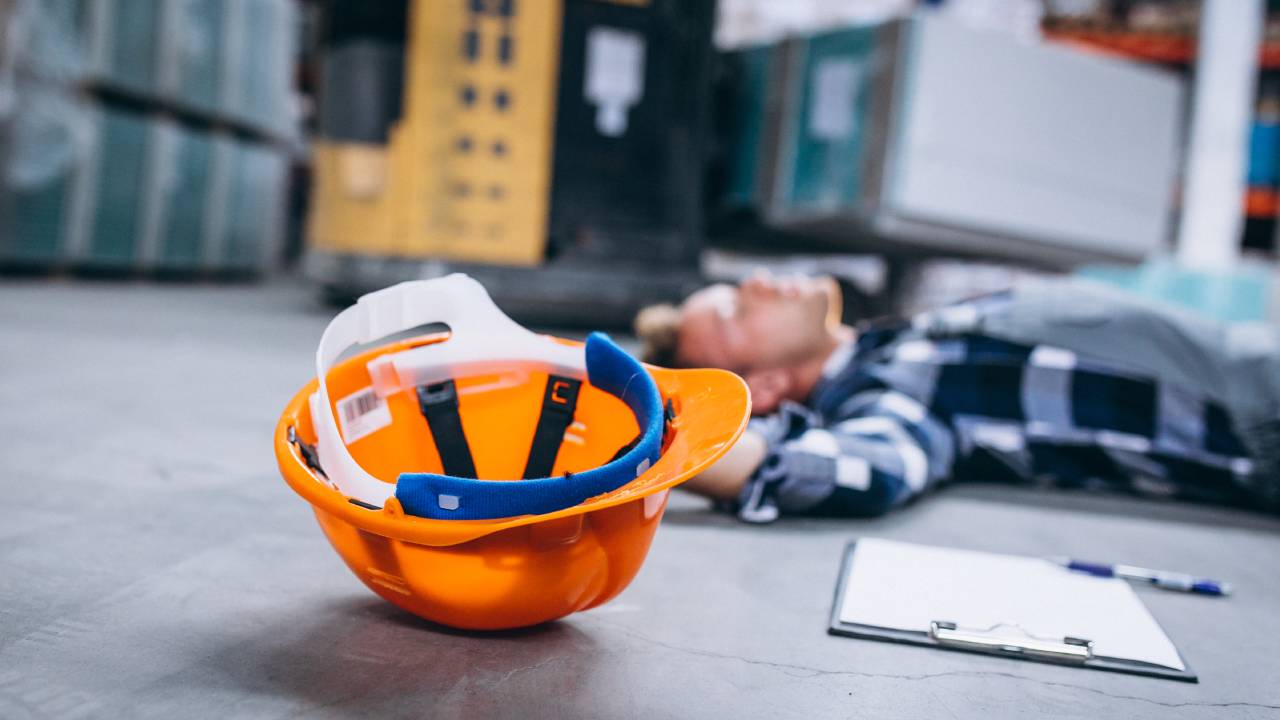
WSIB Work Injury Treatment in Brampton refers to a range of rehabilitation services designed to assist individuals who have experienced an injury or developed a condition related to their job. These treatments aim to support recovery, restore functional ability, and enable individuals to return to the workplace in a manner that is safe and sustainable.
These services typically include physiotherapy, exercise programs, ergonomic assessments, and return-to-work planning. They are developed to address both physical and occupational health challenges that result from the work environment or incidents at the workplace.
The Workplace Safety and Insurance Board (WSIB) is an Ontario government agency that provides financial and healthcare support to workers who are injured or become ill due to their jobs. WSIB covers the cost of approved medical treatments, including WSIB Work Injury Treatment in Brampton, and helps injured workers return to work through recovery-focused programs.
Once an injury is reported and approved by WSIB, injured workers can access services from healthcare providers authorized to deliver care under WSIB guidelines.
If you have suffered a workplace injury or developed a work-related illness, the first step is to report the injury to your employer. From there, a WSIB claim (Form 6) must be filed. Employers are responsible for submitting Form 7, and your healthcare provider will complete Form 8 if treatment is necessary.
Once your claim is approved, you become eligible for WSIB Work Injury Treatment in Brampton through authorized providers. These services are intended to address both acute and long-term symptoms while promoting gradual reintegration into the workforce.
These are among the most frequently reported injuries in the workplace, often caused by lifting, twisting, or slipping. WSIB Work Injury Treatment in Brampton offers structured care plans including physiotherapy, strength-building, and mobility exercises.
Long hours of repetitive movement or poor ergonomics can result in spinal issues. Care focuses on posture correction, manual therapy, and supportive modalities to restore spinal health.
Typing, lifting, or assembly line tasks can cause stress to joints and soft tissues. Treatment involves ergonomic training and exercises to manage inflammation and improve function.
These injuries often require immobilization followed by rehabilitation. WSIB-approved therapy targets the restoration of mobility and prevention of complications.
Damage to muscles, ligaments, or tendons can occur during sudden movements or heavy lifting. Physiotherapy and guided stretching programs form part of the recovery strategy.
Conditions like carpal tunnel syndrome or tendonitis are common. WSIB Work Injury Treatment in Brampton includes activity modifications and strength training to relieve symptoms.
Following surgery for workplace injuries, structured therapy helps rebuild mobility, coordination, and strength.
Once your claim is initiated and approved, you can begin treatment with authorized providers. During the first assessment, a healthcare professional will evaluate your condition, develop a treatment plan, and guide you through the documentation required by WSIB. All necessary updates and progress reports are submitted as part of the ongoing claim process to ensure continued support.
It is important to follow the prescribed treatment plan and attend all scheduled appointments. Failing to adhere to WSIB expectations can affect the continuation of benefits.
The effectiveness of WSIB-related care depends on a few key factors:
A gradual return-to-work strategy is often part of WSIB Work Injury Treatment in Brampton. This might involve modified duties, reduced hours, or temporary assignments until full capacity is regained. Healthcare professionals work closely with both the injured worker and their employer to develop and implement this strategy effectively.
This stage is important not only for physical rehabilitation but also for rebuilding confidence and minimizing the risk of reinjury.
For individuals navigating workplace injuries or occupational health concerns, these services offer structured recovery pathways backed by a regulated provincial system.
....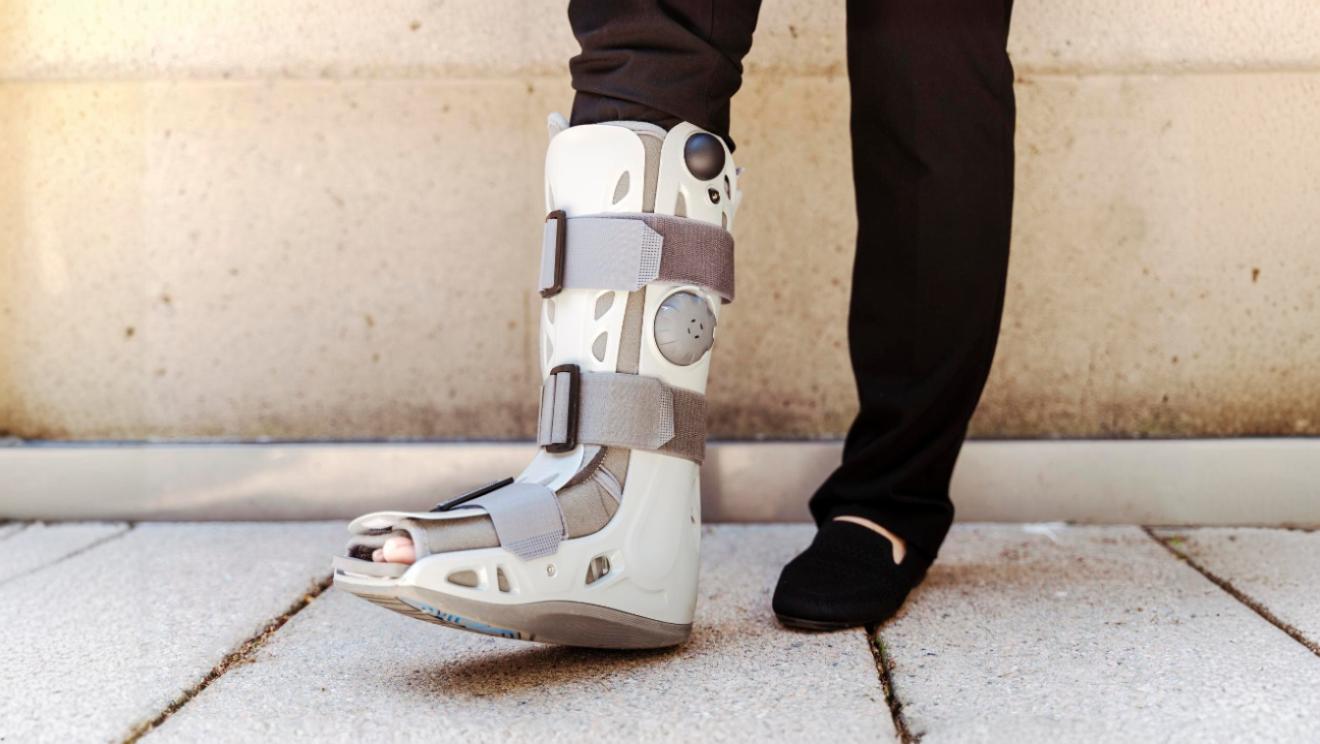
Orthopedic braces are practical tools used to support, align, prevent, or correct musculoskeletal issues. For those living with joint discomfort, injury recovery, or physical conditions affecting movement, Comprehensive Orthopedic Braces in Brampton offer a range of options to address functional limitations. These devices are commonly used to help maintain or regain mobility, stabilize affected areas, and reduce the risk of additional strain.
Orthopedic braces are externally applied devices designed to limit or support specific parts of the body. They are typically prescribed or recommended to assist with rehabilitation or daily function, particularly following an injury, surgery, or in cases of chronic musculoskeletal conditions. Comprehensive Orthopedic Braces in Brampton include devices for the knees, ankles, wrists, elbows, shoulders, neck, and spine. These braces are available in different models to match varying degrees of support, flexibility, and structural reinforcement.
The use of orthopedic braces spans a broad demographic. From athletes recovering from strain to individuals dealing with age-related conditions, many people rely on braces for daily activities. Common reasons for using braces include:
Comprehensive Orthopedic Braces in Brampton are available in several categories depending on the body part involved and the required support level. Below are commonly used types:
These are designed to stabilize the knee joint. Some are made for ligament protection, while others assist with tracking issues or arthritis-related pain.
Often used after sprains or in sports settings, ankle braces help limit inversion or eversion movements that might cause additional damage.
Used for repetitive strain injuries, carpal tunnel syndrome, or post-surgical recovery, these braces restrict wrist movement while allowing daily functionality.
Lumbar supports are worn to reduce strain on the lower back and are commonly used by individuals with disc issues or muscle fatigue.
Typically used after dislocations, surgeries, or rotator cuff injuries, these braces restrict motion and offer compression.
Bracing is often recommended after a clinical assessment. However, the following signs or circumstances may suggest the need for Comprehensive Orthopedic Braces in Brampton:
Obtaining orthopedic braces typically involves several stages. The process begins with a clinical assessment to evaluate the specific issue. Once the assessment is complete, brace selection is done based on the affected area, the type of activity involved, and individual mobility goals.
Fittings ensure the selected brace matches the user’s body measurements and requirements. Adjustments may be necessary over time based on improvements in strength, flexibility, or comfort.
Orthopedic braces vary in their design. Some are rigid, offering a high level of immobilization, while others are made with flexible materials like neoprene for compression and movement assistance. Braces may include straps, hinges, Velcro closures, or padding to improve fit and function. The selection often depends on the intended usage duration and severity of the condition.
In Brampton, access to a broad variety of models ensures individuals can choose from durable, reliable options designed to meet medical or functional specifications.
Braces can be used short-term during recovery or long-term in chronic conditions. Proper care involves routine cleaning, regular checks for wear, and follow-up assessments. Over time, brace needs may evolve, especially if physical therapy or other interventions change the individual’s condition. Keeping in touch with a qualified provider ensures ongoing suitability.
An accurate assessment helps identify the underlying cause of discomfort or dysfunction and ensures that any brace chosen aligns with recovery goals. Working with a professional team for Comprehensive Orthopedic Braces in Brampton allows for more precise recommendations, reducing the risk of improper use or dependency.
Residents seeking orthopedic solutions benefit from local accessibility, a variety of product types, and familiarity with regional healthcare pathways. In Brampton, the ability to obtain fittings, make quick adjustments, or attend follow-up consultations supports consistent use and effective outcomes.
....
In Brampton, the role of a Social Worker for Counselling in Brampton extends beyond traditional therapy. These professionals provide structured, evidence-informed support to individuals dealing with emotional, psychological, and situational difficulties. They help people navigate complex personal issues, explore emotional well-being, and manage life stressors within a supportive environment.
Unlike general therapists, a Social Worker for Counselling in Brampton often integrates social, economic, and community contexts into the counselling process. This makes their role especially meaningful for individuals facing issues influenced by broader life circumstances, such as housing instability, immigration transitions, unemployment, or family conflict.
Many residents seek the support of a Social Worker for Counsellingduring critical life periods – grief, trauma, major transitions, or crises. These professionals provide space for reflection, validation, and the development of coping strategies tailored to each person’s life situation. Sessions often involve exploring patterns of behavior, recognizing emotional responses, and building strategies to manage mental or emotional strain.
Whether it’s an adolescent managing academic pressures, a couple navigating relationship stress, or a senior adjusting to life changes, a Social Worker for Counselling in Brampton works collaboratively with clients to better understand their current experiences and identify steps toward resolution.
Each session with a Social Worker for Counselling in Brampton is designed with the client’s specific context in mind. Assessment begins with understanding the client’s goals and challenges. A customized counselling plan is then created, incorporating emotional support, reflective exercises, and resource navigation.
This individualized approach enables social workers to respond not just to the immediate concerns, but to the underlying factors that may be contributing to distress such as socioeconomic pressures, cultural influences, or lack of access to support services.
By applying techniques such as cognitive-behavioral strategies, motivational interviewing, and strengths-based counselling, the Social Worker for Counselling in Brampton provides support that is both practical and reflective, adapting methods based on ongoing client feedback.
One distinguishing feature of working with a Social Worker for Counselling in Brampton is their ability to connect individuals with appropriate community supports. In addition to direct counselling, these professionals may offer referrals to housing services, family support programs, substance use resources, employment services, or financial aid organizations.
This broad understanding of community systems allows a Social Worker for Counselling in Brampton to serve as a guide for clients who may feel overwhelmed or unsure where to turn. This advocacy role is particularly helpful for newcomers, seniors, or those living with disabilities.
A central goal of counselling is to promote resilience. Social workers help clients identify their own inner resources and learn to manage stressors in a constructive way. Sessions may involve skill-building in areas such as communication, decision-making, stress management, and boundary-setting.
With a Social Worker for Counselling in Brampton, individuals are supported in learning to handle challenges while developing greater emotional awareness and personal agency. This emphasis on resilience does not mean ignoring difficulty it means facing it with thoughtful guidance and a clear plan for growth.
Social workers frequently work in coordination with other service providers to ensure that their clients receive care that is cohesive and comprehensive. For example, if a client is also being treated by a physician, mental health clinician, or addiction specialist, the Social Worker for Counsellingmay communicate with those professionals to support consistent, respectful care planning.
This multi-disciplinary approach helps to ensure that no aspect of a person’s well-being is overlooked. It also allows for smoother transitions between services when required, especially during times of crisis or rapid life changes.
It may be time to connect with a Social Worker for Counselling in Brampton if you’re experiencing persistent stress, relationship struggles, difficulty coping with life events, or emotional confusion. Individuals often reach out when they feel “stuck,” uncertain about the next step, or overwhelmed by day-to-day responsibilities.
Some common areas of support include:
A Social Worker for Counselling in Brampton serves as a key figure in the mental and emotional well-being of the community. Through personalized strategies, collaborative care, and access to practical resources, they provide structured support to those navigating a wide range of life experiences.
By understanding the complex interplay between personal, cultural, and societal influences, a Social Worker for Counsellingis equipped to help individuals make meaningful progress in areas of life that may feel difficult or overwhelming.
....



Lorem Ipsum is simply dummy text of the printing and typesetting industry. Lorem Ipsum has been the industry’s standard dummy text.
We understand that injuries and acute pain can happen unexpectedly. Our emergency physiotherapy services are designed to provide prompt and effective care to help you manage.
Back Pain Physiotherapy in Brampton focuses on addressing physical limitations, movement restrictions, and discomfort linked to various spinal conditions. By examining individual circumstances and applying proven treatment strategies, the aim is to improve mobility and function in a structured and consistent manner.
Back discomfort can develop due to several reasons. It might result from muscle strain, repetitive stress, spinal changes related to age, or nerve compression. Understanding the origin of the issue is essential in planning a course of care that supports recovery and physical balance.
Types of conditions addressed by Back Pain Physiotherapy in Brampton include:
Several lifestyle and work-related habits may increase the chance of back discomfort:
Through careful assessment and individual planning, Back Pain Physiotherapy in Brampton supports individuals by restoring movement, reducing discomfort, and teaching safe movement techniques.
This condition leads to discomfort in the lower spine that may extend through the hips and legs. Physiotherapy can assist by reducing nerve pressure and improving motion.
Disc material pressing on nearby nerves can interrupt daily function. Support includes targeted movements and tissue release methods.
Spinal discs may lose flexibility over time. Care strategies focus on creating more space between vertebrae and improving shock absorption.
Leads to pressure on nerves and limited movement. Guided sessions aim to create space within the spine and reduce pressure.
Misalignment of vertebrae can result in nerve interference. Strengthening and alignment-focused care support improved structure.
Most individuals begin with two to three sessions per week, especially during the early stages of recovery. As function improves, visits may decrease to once weekly or every other week. The frequency is determined by progress and daily needs.
Back Pain Physiotherapy in Brampton supports individuals by focusing on:
Shoulder Pain Treatment in Brampton focuses on restoring joint function, reducing discomfort, and improving range of motion for individuals experiencing issues in the shoulder area. Each person’s condition is assessed with care to determine the underlying cause, followed by a plan designed to support recovery through targeted movement strategies and structured care routines.
Shoulder discomfort may be caused by a range of factors from repetitive strain to joint degeneration or trauma. The shoulder is a complex structure that includes muscles, tendons, ligaments, and bones working together to support movement. When one or more of these components are affected, function may be limited and pain may occur.
Shoulder Pain Treatment in Brampton addresses common conditions such as:
Understanding what contributes to shoulder issues can help prevent recurring problems. Some of the most common factors include:
Care plans begin with an individual assessment of joint motion, muscular strength, posture, and activity limitations. Based on this, a structured approach is applied using methods supported by clinical standards. Shoulder Pain Treatment in Brampton may include the following:
Gentle joint and soft tissue mobilization to reduce stiffness and improve joint alignment.
Movements that focus on improving shoulder stability, strength, and flexibility are introduced gradually, depending on tolerance and condition stage.
Education and training to modify postural habits that place extra strain on the shoulder complex.
Retraining movement patterns to improve efficiency and reduce stress on injured or overused structures.
Guidance on workstation or lifestyle changes to minimize aggravating factors and support smoother daily motion.
Common among athletes, workers, and older adults. Pain is often felt when lifting the arm or reaching behind the back.
Can develop gradually and limit all directions of shoulder movement. Often appears without a clear cause, especially in mid-life.
Leads to pain during overhead motion. Addressing movement mechanics and tissue tightness is key to improvement.
Results in swelling and discomfort in the outer shoulder, especially during rest or nighttime.
Often caused by trauma, it leads to joint weakness and recurring instability. Strength training and movement control help manage symptoms.
The number of care sessions depends on the nature and duration of the condition. In early stages, sessions may be held two to three times per week to support active recovery. As progress is made, the frequency can be adjusted. The overall plan is guided by how well the body responds to movement and strategy-based care.
Treatment aims to:
By focusing on long-term joint health and movement efficiency, individuals are guided through recovery with attention to safety, consistency, and progress tracking. With Shoulder Pain Treatment in Brampton, every plan is adjusted to match the needs and capabilities of the person receiving care.
....
Knee Pain Physiotherapy in Brampton focuses on identifying the source of knee-related discomfort and movement challenges. Whether caused by injury, overuse, or gradual joint changes, knee issues can interfere with walking, bending, and everyday activity. Each plan is developed with a clear understanding of the individual’s symptoms, physical condition, and mobility goals.
Knee pain can result from mechanical stress, tissue irritation, or injury. At Knee Pain Physiotherapy in Brampton, various conditions are addressed, including:
Also called anterior knee pain, this occurs near or around the kneecap and may be related to movement patterns or imbalances in muscle control.
Cartilage between the upper and lower leg bones may tear or become worn over time, leading to reduced joint efficiency and occasional swelling or clicking.
Sprains or injuries to stabilizing tissues such as the ACL or MCL are often caused by sudden stops, pivots, or trauma.
Gradual wear within the knee structure may limit flexibility and affect joint use.
Repeated movement or impact can result in stress to tendons in the front or back of the knee.
Several habits or situations may increase stress on the knee joint:
Uneven muscle use, incorrect walking patterns, or hip misalignment may overload the knee.
Limited movement can weaken supportive tissues and reduce joint stability.
Wearing unsupportive shoes may shift pressure through the legs in a way that increases strain.
Activities involving regular kneeling, climbing, or jumping may place additional demands on the joint.
More weight on the frame increases pressure on the knee with each step.
The process begins with a full assessment of posture, range of motion, balance, and muscular function. Based on these findings, care may include the following:
Hands-on work is used to ease muscle tension, restore alignment, and allow more efficient movement.
Stretching and strengthening programs are introduced to improve muscle control and reduce joint load.
Teaching safer techniques for walking, squatting, and stepping can reduce excess pressure on the joint.
Modifying common tasks, furniture setup, or work positions can help limit irritation throughout the day.
Temperature-based tools or assisted motion exercises may help ease stiffness during the early phase of care.
Uneven force around the kneecap may cause clicking, grinding, or discomfort when using stairs or sitting for long periods.
Tears or softening of cartilage may cause instability, reduced bending capacity, or locking.
Pain or lack of control after sudden impact or twisting may indicate a strain or partial tear, requiring gradual recovery steps.
Wear from repetitive use over time may limit how far the knee can bend or extend.
Tendons stressed by work or sports may become thickened or irritated, making certain motions difficult or painful.
Session frequency depends on the stage of recovery. In early stages, care may begin with two to three visits per week. As movement improves and pain levels decrease, sessions may reduce in frequency. The plan adapts to how the individual responds and how much support they need to reach their goals.
Knee Pain Physiotherapy in Brampton emphasizes:
Arthritis refers to a group of conditions that affect the joints, causing inflammation, stiffness, and discomfort. It commonly impacts the knees, hips, spine, and hands. There are multiple types, such as osteoarthritis, rheumatoid arthritis, and psoriatic arthritis, each with distinct underlying causes and symptoms.
While arthritis is often associated with aging, it can affect individuals at various stages of life. Symptoms may begin gradually and worsen over time, especially if left unmanaged.
Managing arthritis typically involves a combination of physical activity, joint protection techniques, and support services. One method that can make a meaningful difference is physiotherapy.
Arthritis Physiotherapy in Brampton focuses on improving joint movement, reducing stiffness, and guiding clients through daily challenges. The approach is methodical, using tested physical techniques rather than medication or surgical intervention.
Physiotherapists use multiple physical interventions to address joint discomfort, postural alignment, muscular balance, and limited mobility — all of which are common in arthritis cases.
This service begins with an assessment. The physiotherapist will observe posture, gait, strength, flexibility, and range of motion. A plan is then designed based on individual challenges.
Key components of arthritis-focused sessions may include:
Throughout the process, the client is monitored for progress and modifications are made as needed.
Delaying physiotherapy may lead to a decrease in mobility, more intense discomfort, or dependency on aids. Early signs such as joint stiffness in the morning, swelling after activity, or decreased motion are indicators to consult a physiotherapist.
For those already diagnosed, ongoing sessions may slow functional decline and provide movement strategies suited to various environments — whether at work, home, or during leisure activity.
Arthritis Physiotherapy in Brampton often helps people navigate these specific scenarios:
Rather than aiming to eliminate arthritis entirely — which is not currently possible — the goal is to reduce the impact it has on daily life.
Registered physiotherapists with training in musculoskeletal conditions typically deliver arthritis-focused treatment. Their role includes assessment, exercise instruction, movement education, and manual techniques. Clients often attend sessions in community clinics, health centres, or private practices.
In Brampton, there are multiple centres offering Arthritis Physiotherapy, and most allow walk-in or referral-based appointments.
Each session lasts between 30 to 60 minutes and may involve:
Progress is usually tracked across multiple visits. Adjustments are made based on symptom response and evolving needs.
While physiotherapy is a key part of arthritis care, other elements may also contribute:
Education is ongoing, and clients are encouraged to remain active while learning how to prevent joint overuse.
Arthritis Physiotherapy in Brampton may be covered under extended health benefits, motor vehicle accident claims, or WSIB (Workplace Safety and Insurance Board) if related to occupational injury. Seniors’ programs or OHIP-funded services might offer limited coverage in certain settings.
It’s advised to check with individual clinics and insurance providers about coverage options and documentation needed.
Not all clinics operate the same way. When considering options, it can be helpful to look for:
Some clients may also prefer in-home sessions or virtual guidance, depending on mobility or transportation limitations.
....We offer a range of flexible pricing options tailored to meet your physiotherapy needs. Whether you’re starting with an initial assessment or seeking long-term care, our plans provide excellent value with expert care.
This plan is perfect for individuals seeking and pain, improve injuries.
Our Basic Physiotherapy Plan for clients looking treatment.
At Physiocare, we pride ourselves on providing exceptional physiotherapy services that deliver real results. But don’t just take our word for it.